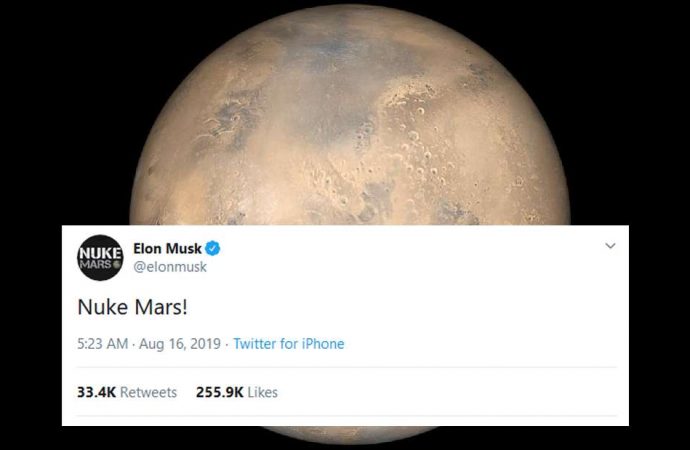Elon Musk has taken to Twitter to re-hash a theory he had a few years ago: dropping nuclear bombs on Mars to release trapped carbon dioxide and heat up the planet.
Source: IFLScience
The goal is to create the necessary conditions to turn the Red Planet into a habitable world, i.e. to terraform Mars. He first endorsed the idea in 2015 in an interview with Stephen Colbert.
The vague details had enough merit for actual scientists to use their time to investigate the concept’s feasibility. But it is not possible. In a paper published last year, astronomers investigated just how much carbon dioxide can be liberated from Mars and there is literally not enough to make the enterprise worthwhile.
“There has been a lot of public discussion recently about possibly terraforming Mars to make the planet able to be colonized,” Professor Bruce Jakosky, co-first author of the study, previously told IFLScience. “Our results show that this cannot be done with existing technology – that it is not possible, for example, to simply mobilize carbon dioxide that is already on the planet and put it into the atmosphere.”
When the study came out last year, Elon Musk took the news calmly. Just kidding, he had a fight with Discover Magazine on Twitter and claimed, despite what current science says, that there is enough CO2 on Mars to make terraforming possible.
Over a year later, Musk is back defending his idea. Has he got a new analysis showing that he was right? No. But he’s got T-shirts that say “Nuke Mars” on the front. Objectively, as efficient at terraforming Mars as actual nukes.
As previously reported in Nature Astronomy, even if all the carbon dioxide in Mars’ poles were to be released it would amount to just 1.5 percent of what’s necessary to create the needed greenhouse effect. The researchers even considered a scenario where most of the planet’s surface is completely reprocessed to extract more carbon dioxide and found even this would only add less than 10 percent of the requirement.
“Too much of the carbon dioxide has been lost to space, and that which remains is very hard to mobilize and put into the atmosphere. While terraforming Mars still could be done by manufacturing greenhouse gases such as freon, that is way beyond the capabilities of our present technology and is not something that could be carried out soon,” Professor Jakosky explained.
Releasing CO2 would be a costly and very inefficient endeavor. The increase in heat would not be enough to keep the carbon dioxide from ending up back in the ground. If Mars can be turned into a second Earth it is clearly a conversation for the distant future. And we still need to discuss whether it should be first.

































Leave a Comment
You must be logged in to post a comment.